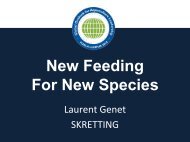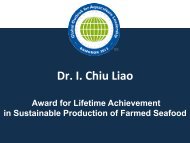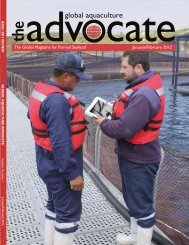May/June 2010 - Global Aquaculture Alliance
May/June 2010 - Global Aquaculture Alliance
May/June 2010 - Global Aquaculture Alliance
Create successful ePaper yourself
Turn your PDF publications into a flip-book with our unique Google optimized e-Paper software.
marketplace<br />
Consumer Attitudes Toward <strong>Aquaculture</strong><br />
Spanish Study Correlates Knowledge, Opinions<br />
This supermarket signage shows an “unbeatable price” for farmed seabass. Labeling<br />
at traditional seafood markets does not always identify the sources of seafood.<br />
Summary:<br />
Consumer beliefs about the safety<br />
and sustainability of aquaculture<br />
are statistically related concepts<br />
that allow their reduction into a<br />
single attitude index. As consumers<br />
further identify safety and sustainability<br />
in the aquaculture, their<br />
opinions about farmed seafood<br />
tend to become more favorable.<br />
The industry can benefit by assuring<br />
that both conditions are<br />
satisfied in their operations and<br />
communicating them in an understandable<br />
language for all segments.<br />
Following the bovine food crisis in<br />
the last decade of the 20th century, consumers’<br />
awareness and attitudes toward<br />
food-harvesting methods increased in<br />
importance in purchase decisions. Attitudes<br />
toward technology related to the<br />
consumers’ predisposition to purchase<br />
new products and the expectation of possible<br />
risks.<br />
Perceived risk in food technology is<br />
also consistent with consumers’ social<br />
environment opinions, which include cultural<br />
habits, media and relatives. Input<br />
from the social environment can be<br />
stronger than other personal factors in<br />
decisions regarding food innovations.<br />
Pre-existing Prejudice?<br />
Despite being the only harvesting<br />
method that can guarantee full traceability<br />
in seafood markets, aquaculture is perceived<br />
by conservative consumers as an<br />
unnatural and less authentic way to provide<br />
markets with seafood. This is especially<br />
the case in regions such as the<br />
Mediterranean countries, which have<br />
deep-rooted culinary traditions and<br />
plenty of seafood in the common diet.<br />
A survey funded by the Spanish Ministry<br />
of Fisheries and conducted yearly<br />
from 2003 to 2007 revealed that in Spain,<br />
a majority of seafood consumers assessed<br />
cultured species as of less quality and<br />
more unsafe than their wild equivalents.<br />
This showed some sort of prejudice<br />
among these consumers. This study provided<br />
the data used to arrive at the results<br />
presented here.<br />
José Fernández-Polanco,<br />
Ph.D.<br />
Faculty of Business and Economics<br />
Universidad de Cantabria<br />
Avda. de los Castros E-39005<br />
Santander, Cantabria, Spain<br />
polancoj@unican.es<br />
Ladislao Luna, Ph.D.<br />
Ignacio Llorente<br />
University of Cantabria<br />
Attitudes Affect Purchasing<br />
Consumers’ attitudes toward seafoodharvesting<br />
methods and their effects on<br />
purchase decisions are as important as<br />
attitudes toward the products themselves.<br />
Knowledge of production methods<br />
informs consumers about aspects that<br />
usually need external assistance to be<br />
assessed.<br />
It provides extrinsic keys to make<br />
expectations of quality, safety conditions<br />
and possible impacts on the environment<br />
and surrounding communities, which in<br />
turn are associated with the likelihood of<br />
purchase. Studies have shown that consumers<br />
value, and are also willing to pay<br />
for, extrinsic attributes that guarantee<br />
seafood safety and the use of sustainable<br />
fishing practices.<br />
After discussions with groups of producers,<br />
consumers and retailers, a set of<br />
scales attempting to measure consumer<br />
beliefs about the safety and sustainability<br />
of aquaculture methods and products was<br />
used with the questionnaires collected<br />
between 2005 and 2007 (Table 1).<br />
Although the means of the scales for all<br />
three years were over 3 based on a scoring<br />
range of 1 to 5, variances of each measure<br />
indicated a polarized behavior among<br />
respondents, who were divided into<br />
favorable and unfavorable segments.<br />
Factor reduction was applied to<br />
obtain an attitude index from the scales,<br />
with successful results that explained an<br />
average 60% of the total variance of the<br />
five scales in the three years, indicating a<br />
strong level of association between consumer<br />
beliefs about safety and sustainability<br />
issues of aquaculture. According to<br />
Some consumers who shop at traditional fish markets may be less aware<br />
of the beneifts of aquaculture.<br />
the mean values near 3 obtained in the<br />
scales, the equivalent factor mean would<br />
indicate an indifferent position toward<br />
aquaculture among consumers. Using this<br />
mean to divide the samples, favorable and<br />
unfavorable segments were quantified<br />
(Table 2).<br />
The effects of the attitudes on consumers’<br />
beliefs and assessments of different<br />
cultured species were studied using<br />
structural equation models, and their<br />
results were presented at several international<br />
conferences.<br />
The models indicated that the more<br />
favorable the attitude, as reflected in<br />
higher scores provided by respondents on<br />
the physical quality and safety of cultured<br />
species, the higher disposition to pay for<br />
them. These results were confirmed with<br />
seabream, seabass, turbot and trout.<br />
Industry Communications<br />
Based on the above results, industry<br />
may be interested in improving consumers’<br />
attitudes towards aquaculture. Assuming<br />
that industry can assure seafood safety and<br />
sustainability, consumer perceptions can<br />
vary depending on the amount and quality<br />
of the information they receive and their<br />
capability to understand it.<br />
Information about aquaculture can<br />
come from many different sources. Generic<br />
institutional advertising and information<br />
provided at the point of purchase were two<br />
sources studied within this research.<br />
It was found that higher credibility of<br />
the institutional source led to a more<br />
favorable attitude towards aquaculture.<br />
Different levels of application of regulations<br />
on labeling also resulted in different<br />
levels of attitude.<br />
While at large supermarkets, labeling<br />
for all species included the harvesting<br />
method, as required by law, this information<br />
was not always available in traditional<br />
stores. As a result, attitudes toward aquaculture<br />
were more favorable at self-service<br />
stores than at traditional fish markets and<br />
fishmongers.<br />
Finally, the capability to understand the<br />
information received by consumers was<br />
affected by several personal variables. Age<br />
and education level were two such factors.<br />
Respondents between 30 to 64 years old<br />
from all samples had better attitudes toward<br />
aquaculture than the other two segments,<br />
which were unfavorable among older consumers.<br />
Also, attitudes improved as the<br />
respondents’ education level increased,<br />
while unfavorable attitudes were frequent in<br />
Table 1. Yearly mean values (based on a 1-5 scale)<br />
obtained for consumer beliefs about aquaculture.<br />
<strong>Aquaculture</strong> produces safe foods<br />
<strong>Aquaculture</strong> produces quality foods<br />
Consumption of cultured species contributes to health care<br />
Consumption of cultured species contributes to the preservation<br />
of marine resources<br />
I would recommend consumption of cultured species<br />
2005 2006 2007<br />
less-educated respondents.<br />
This last result suggested the need to<br />
diversify communication channels and<br />
messages to assure favorable beliefs across<br />
all market segments. Existing communications<br />
appeared to fail in transmitting positive<br />
information to the less-educated segments,<br />
who perhaps found difficulties in<br />
understanding technical information and<br />
experienced confusion and prejudices.<br />
60 <strong>May</strong>/<strong>June</strong> <strong>2010</strong> global aquaculture advocate global aquaculture advocate <strong>May</strong>/<strong>June</strong> <strong>2010</strong> 61<br />
3.52<br />
3.50<br />
3.10<br />
3.51<br />
3.22<br />
3.60<br />
3.55<br />
3.43<br />
3.86<br />
3.37<br />
3.41<br />
3.40<br />
3.18<br />
3.56<br />
3.51<br />
Table 2. General attitudes<br />
of Spanish consumers<br />
toward aquaculture.<br />
Favorable<br />
Unfavorable<br />
2005 2006 2007<br />
53.4%<br />
46.6%<br />
51.4%<br />
48.6%<br />
global aquaculture<br />
52.8%<br />
47.2%<br />
e som thing<br />
n w<br />
NOW... read each issue<br />
of the Advocate in<br />
electronic form at<br />
www.gaalliance.org.<br />
It’s informative. It’s easy.<br />
And it’s free!<br />
the





